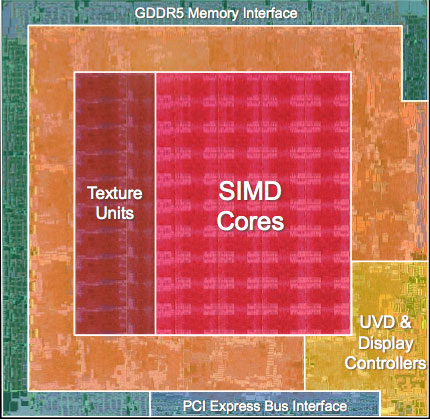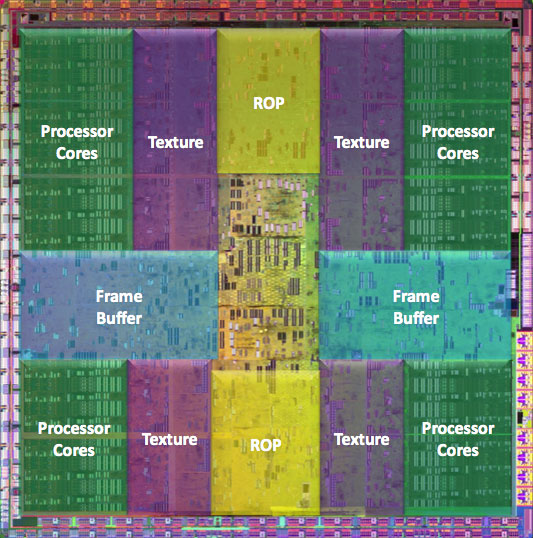The Radeon HD 4850 & 4870: AMD Wins at $199 and $299
by Anand Lal Shimpi & Derek Wilson on June 25, 2008 12:00 AM EST- Posted in
- GPUs
Wrapping Up the Architecture and Efficiency Discussion
Engineering is all about tradeoffs and balance. The choice to increase capability in one area may decrease capability in another. The addition of a feature may not be worth the cost of including it. In the worst case, as Intel found with NetBurst, an architecture may inherently flawed and a starting over down an entirely different path might be the best solution.
We are at a point where there are quite a number of similarities between NVIDIA and AMD hardware. They both require maintaining a huge number of threads in flight to hide memory and instruction latency. They both manage threads in large blocks of threads that share context. Caching, coalescing memory reads and writes, and handling resource allocation need to be carefully managed in order to keep the execution units fed. Both GT200 and RV770 execute branches via dynamic predication of direction a thread does not branch (meaning if a thread in a warp or wavefront branches differently from others, all threads in that group must execute both code paths). Both share instruction and constant caches across hardware that is SIMD in nature servicing multiple threads in one context in order to effect hardware that fits the SPMD (single program multiple data) programming model.
But the hearts of GT200 and RV770, the SPA (Steaming Processor Array) and the DPP (Data Parallel Processing) Array, respectively, are quite different. The explicitly scalar one operation per thread at a time approach that NVIDIA has taken is quite different from the 5 wide VLIW approach AMD has packed into their architecture. Both of them are SIMD in nature, but NVIDIA is more like S(operation)MD and AMD is S(VLIW)MD.

AMD's RV770, all built up and pretty
Filling the execution units of each to capacity is a challenge but looks to be more consistent on NVIDIA hardware, while in the cases where AMD hardware is used effectively (like Bioshock) we see that RV770 surpasses GTX 280 in not only performance but power efficiency as well. Area efficiency is completely owned by AMD, which means that their cost for performance delivered is lower than NVIDIA's (in terms of manufacturing -- R&D is a whole other story) since smaller ICs mean cheaper to produce parts.

NVIDIA's GT200, in all its daunting glory
While shader/kernel length isn't as important on GT200 (except that the ratio of FP and especially multiply-add operations to other code needs to be high to extract high levels of performance), longer programs are easier for AMD's compiler to extract ILP from. Both RV770 and GT200 must balance thread issue with resource usage, but RV770 can leverage higher performance in situations where ILP can be extracted from shader/kernel code which could also help in situations where the GT200 would not be able to hide latency well.
We believe based on information found on the CUDA forums and from some of our readers that G80's SPs have about a 22 stage pipeline and that GT200 is also likely deeply piped, and while AMD has told us that their pipeline is significantly shorter than this they wouldn't tell us how long it actually is. Regardless, a shorter pipeline and the ability to execute one wavefront over multiple scheduling cycles means massive amounts of TLP isn't needed just to cover instruction latency. Yes massive amounts of TLP are needed to cover memory latency, but shader programs with lots of internal compute can also help to do this on RV770.
All of this adds up to the fact that, despite the advent of DX10 and the fact that both of these architectures are very good at executing large numbers of independent threads very quickly, getting the most out of GT200 and RV770 requires vastly different approaches in some cases. Long shaders can benefit RV770 due to increased ILP that can be extracted, while the increased resource use of long shaders may mean less threads can be issued on GT200 causing lowered performance. Of course going the other direction would have the opposite effect. Caches and resource availability/management are different, meaning that tradeoffs and choices must be made in when and how data is fetched and used. Fixed function resources are different and optimization of the usage of things like texture filters and the impact of the different setup engines can have a large (and differing with architecture) impact on performance.
We still haven't gotten to the point where we can write simple shader code that just does what we want it to do and expect it to perform perfectly everywhere. Right now it seems like typical usage models favor GT200, while relative performance can vary wildly on RV770 depending on how well the code fits the hardware. G80 (and thus NVIDIA's architecture) did have a lead in the industry for months before R600 hit the scene, and it wasn't until RV670 that AMD had a real competitor in the market place. This could be part of the reason we are seeing fewer titles benefiting from the massive amount of compute available on AMD hardware. But with this launch, AMD has solidified their place in the market (as we will see the 4800 series offers a lot of value), and it will be very interesting to see what happens going forward.










215 Comments
View All Comments
StevoLincolnite - Wednesday, June 25, 2008 - link
Of course it can, There are benchmarks isn't there?Seriously ANY Direct X 9 card can run Crysis, The Quality and Performance is a different matter.
Inkjammer - Wednesday, June 25, 2008 - link
I have a 9800 GX2 in my primary gaming rig, but I've been debating on what card to drop into my Photoshop/3DS Max art rig. I've been waffling over it for some time, and was going to settle on an 8800GT... but after seeing this, my mind's set on the 4850. It definitely appears to offer more than enough power to handle my art apps, and allow me to use my second PC a gaming rig if need be... all without breaking the bank.This'll mark my return to buying ATI hardware since the X800 was king.
weaksideblitz - Wednesday, June 25, 2008 - link
this is a welcome development although im only buying a 4850 :)Locutus465 - Wednesday, June 25, 2008 - link
Very much so, actually from where I sit I think all AMD really needs to do is get a SAM2+ CPU out there that can compete with intel at least similarly to how this card competes with nvida and they'd have one hell of a total platform solution right now. As for upgrading my vid card... I just finished upgrading to the Phenom 4x and Radeon 3870 so I'll be sticking with that for a while. Quite honestly that platform can pretty much run anything out there already as it is, so I'm feeling pretty confident my current setup will last a couple years at least.Lifted - Wednesday, June 25, 2008 - link
Ditto. If I can get a 4850 for ~$150 or so, that's what I'm doing as well.billywigga - Friday, August 29, 2008 - link
where are you getting it from best buy or somethingClauzii - Wednesday, June 25, 2008 - link
That leaves 50 for a better cooler ;)Lifted - Wednesday, June 25, 2008 - link
Is there any reason the first pages of benchmarks have SLI setups included in the charts, but you wait until the end of the article to add the CF? I'd think it would make the most sense to either include both from the start or hold both until the end.Anand Lal Shimpi - Wednesday, June 25, 2008 - link
The original idea was to format it like the 4850 preview, keep things simple early on but offer SLI/CF graphs later in the article for those who wanted them.It looks like in the mad rush to get things done it didn't work out that way, I'll see if it's possible to clean it all up but right now we've got a lot of other minor touchups to do first :)
Take care,
Anand
TechLuster - Wednesday, June 25, 2008 - link
Anand,I really like your idea of "keeping things simple early on" by only including configurations that us mere mortals can afford at first (say, all single-GPU configs plus "reasonable" multi-GPU configs less than ~$400 total), and then including numbers for ultra high-end multi-GPU configs at the end (mainly just for completeness and also for us to drool over--I doubt too many people can afford more than one $650 card!).
Anyway, great job on the review as always. I think you and Derek should get some well-deserved rest now!
-TL